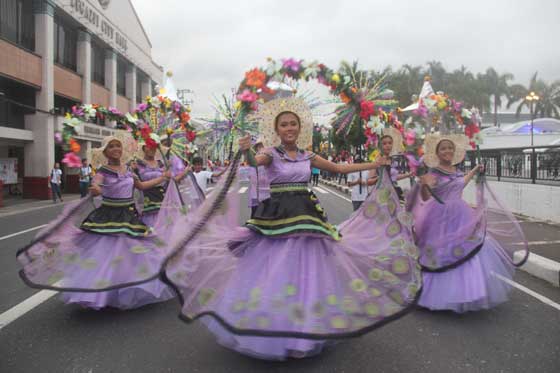PRETTY girls holding small bamboo arches festooned with paper flowers or waving their loose skirts as if they were winnowing baskets and boys in shawls beating their tambourines or colorful castanets.
These are the first steps in Pastores-A-Belen, a song and dance ritual that marks the start of a festive re-enactment of the oldest Yuletide celebration in Bicol, especially in Legazpi City. It is staged before the celebration of the Mass on first day of the Misa de Gallo.
The Mexican-influenced dance Pastores a Belen, literally “shepherds on their way to the manger,” recalls the journey of nocturnal shepherds on their way to Bethlehem, the Biblical birthplace of the Child Jesus.
The Spaniards introduced this dance in Mexico and it eventually found its way to the Philippines. It is still being performed to this day in various parts of the country, from Cagayan Valley in the north to Zamboanga in the south.
The song Pastores-A-Belen, is a Christmas carol attributed to our national hero, Dr. Jose Rizal, who composed it more than a century ago. With the dance and this song, Bicolanos mark the start of the yuletide season through what they call the Kagharong.
The Kagharong, is a re-enactment of Saint Joseph and the Virgin Mary’s departure from Egypt as they travelled to Bethlehem – on foot by the light of a star, the same one that the Magi followed. Not finding a home, Mary and Joseph sought refuge on that cold night in a cave. There, in a manger – actually the feeding trough of farm animals – the Christ Child was born. Hence, the shepherds and farm animals have always figured in traditional Nativity scenes.
Pastores Bicol is an annual celebration staged with Legazpi City government partnered with the Department of Tourism in 2001 and the Albay provincial government in 2004.
Legaspi Mayor Noel Rosal said: “The Pastores is ours and no other areas or region in the country is doing it in the same manner we are performing it here in Bicol. This is part of our festive cultural heritage as we celebrate Christmas which we can share with our local and foreign tourists.”
Maria Nini Ong-Ravanilla, DOT regional director in Bicol said that Pastores Bicol has become a symbol of hope, humility and love. She added that this is the Bicolanos’ way of preserving the region’s colorful heritage and culture especially during the yuletide season.
Pastores in the Bicolano culture is called rokyaw, a manifestation of the highest respect and love for Emmanuel.
“Aside from being a Yuletide entertainment presentation, it is a symbol of hope because after disasters or calamities, Bicolanos from all walks of life stand up again and together we rebuild the remaining and crumbled pieces with love and meekness. A true spirit of brotherhood, kindness; unity and love as Christ taught us,” Ravanilla said.
Pastores in other parts of Bicol
George Leonard in his book, The Asian Pacific American Heritage, considers the Pastores as having vestiges of the Medieval ring-dance or carol as it was then known. In Bicol, he claims, the Franciscan friars introduced the dance in 17th century. This was the religious order which converted the region to Christianity.
“In Iriga, this custom is alive. Children dressed as shepherds form a circle and joining hands, they sing and walk in rhythmic dance-steps in the manner of the original carols,” Leonard noted.
Tapping children for religious performances like the pastores was a conversion strategy of the friars, says children’s literature advocate and writer, Dr. Christine Bellen. “Through the children, the parents get to be involved themselves and eventually join the new faith,” she said.
Former Cultural Center of the Philippines official Nicanor Tiongson, however, traces the origin of the dance to the pastorela chica of the Michoacan in Mexico. “In Michoacan, the pastores dance quadrilles, wearing short, sometimes long, dresses (for females) or knee-length pants and long sleeved shirts (for males). Both sexes wear bands and sashes, and wide-brimmed hats festooned with flowers, ribbons and plumes,” he writes in Mexican-Philippine Relations in Traditional Folk Theater which appeared in Philippine Studies V.
In the Bicol version of the pastores, the girls wear full skirts, wide-brimmed hats decorated with ribbons of flowers reminiscent of the dresses of the Mexican painter, Frida Kahlo, in her autoretratos or self-portraits; while the boys sport long-sleeved shirts, covered with shawls and decorated hats.
Once the Christmas season sets in, the pastores who had been trained for months by a maestra, would go around the towns singing a Catalonian Villancico. In return, they are given money or food by the house owners they sing carol. To this day, the pastores has in fact become a fund raising activity for religious groups.
In Talisay, Camarines Norte a version documented by the late National Artist for Dance, Ramon Obusan shows the pastores accompany their singing with variations of the quadrille which now include turno or turning movements, paso doble and saludo (salute), as they wave their hands holding decorated arches or handkerchiefs.
In Iriga City, Obusan’s student, Romeo Abano is helping keep the pastores alive through the teachers of the Department of Education. Abano’s great, great grandmother herself was a pastores teacher. Some of Abano’s students have even competed in the annual Pastores-a-Belen competition sponsored by the DOT in Bicol.



